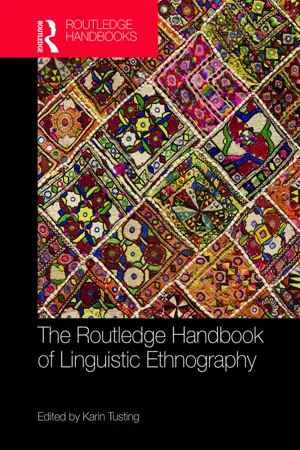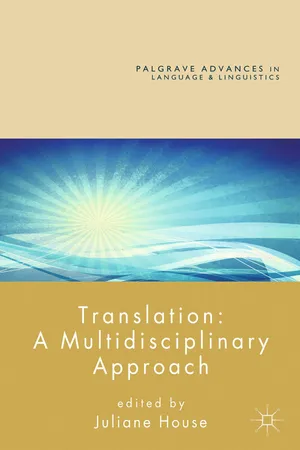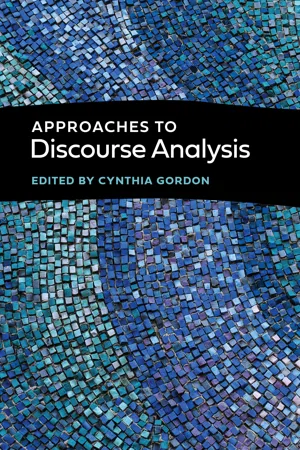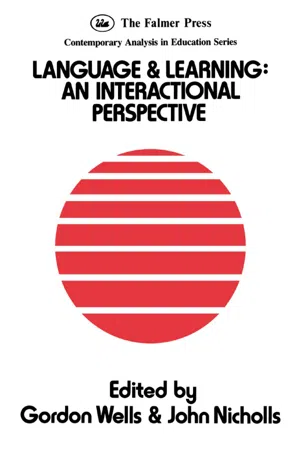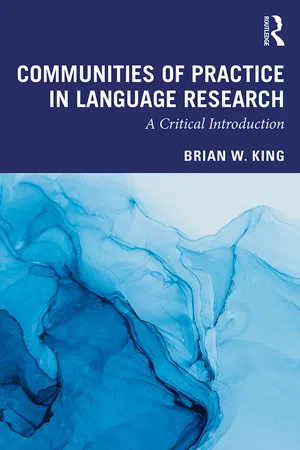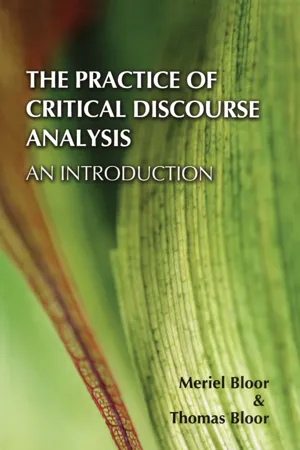John Swales Discourse Communities
John Swales' concept of discourse communities refers to groups of people who share common goals, interests, and ways of communicating within a particular field or area of study. These communities have their own specialized language and norms, and they play a crucial role in shaping the discourse and practices within their respective fields. Swales' work has been influential in understanding how language is used within specific professional and academic contexts.
7 Key excerpts on "John Swales Discourse Communities"
- eBook - ePub
- Karin Tusting, Karin Tusting(Authors)
- 2019(Publication Date)
- Routledge(Publisher)
...One can note, on the one hand, a continuation of more linguistic uses of the term, in which discourse is viewed as the layer of meaning which is tied more directly to situations of language use. The focus here is often on large collections of verbal material of a particular situation or activity type and the use of quantitative methods and techniques of corpus linguistics (Biber et al., 2007). Specific discourse-related themes are selected for closer attention (e.g. Warren, 2006 on aspects of naturalness in informal conversational language use). On the other hand, recent decades have witnessed the formulation of a broad project of discourse studies which more holistically views language use, often in combination with other forms of semiotic behaviour, from the angle of ‘social practice’. Much discourse research thus simultaneously attends to aspects of text and talk, processes of interpretation and cognition, and social-actional dimensions of communicative behaviour as well as its functioning at the level of ideological reproduction and socio-cultural transformation. Especially in the latter tradition, discourse analysis has often (if not mostly) stood in an applied relationship to the social world, with discourse research oriented to the identification of recommendations for practice (here echoing Brumfit’s definition of applied linguistics as engaged with real-world problems and issues in which language plays a central role (Brumfit, 2001))...
- eBook - ePub
Corpus Linguistics for Vocabulary
A Guide for Research
- Paweł Szudarski(Author)
- 2017(Publication Date)
- Routledge(Publisher)
...p.160 Chapter 9 Discourse, pragmatics and vocabulary 9.1 What is discourse and discourse analysis? Discourse is a notoriously difficult term to define but in general “it refers to units of language above the level of the sentence” (McEnery and Hardie 2012: 132). In a detailed definition, Thornbury (2010) enumerates three main senses of the term: discourse as connected text, discourse as language in use and discourse as social practices. Similarly, Gee (1999) distinguishes between discourse (with a little d) and Discourse (with a capital D). While the former is concerned with language in use in specific contexts, the latter involves not only linguistic practices but also systems of knowledge, beliefs and other elements of social life. This distinction is also reflected in Groom, Charles and John’s (2015) discussion of discourse-oriented approaches. The authors posit that there are two basic types of discourse analysis: the first one concentrates on the structure of different kinds of interactions and the other is the study of conventionalized meanings, values and ideologies held by specific social groups. What transpires from the above definitions is that discourse analysis is an umbrella term and it encompasses a set of mainly qualitative methods and practices aimed at exploring specific examples of language in use and studying how meaning emerges in the process of interaction (Biber, Connor and Upton 2007). Corpus linguistics, in turn, tends to be perceived as a quantitative methodology, which relies on frequency data and statistical procedures and seeks to reveal typical patterns of natural language use. It becomes evident then that there are inherent differences between these two approaches to the study of language...
- eBook - ePub
- J. House, J. House(Authors)
- 2015(Publication Date)
- Palgrave Macmillan(Publisher)
...3 Discourse and Translation – A Social Perspective Ian Mason The concept of ‘discourse’ (whether simply in the sense of the organisation of verbal interaction or as uses of language giving voice to the meanings and values of social institutions) has been current in translation studies for many years without generating a great deal of debate about how discourses actually affect translator behaviour. Starting from Foucault’s notion of discours, and drawing on (critical) discourse theory (Blommaert 2005) and Hatim’s (e.g. 2001) notion of socio-textual practices, this chapter places discourses and translators within the framework of communities of practice (Wenger 1998). Viewing translation as a socially situated activity implies consideration of the multiple communities of which translators (and other text users) are members – and the essential role of discourses in negotiating, reinforcing or challenging power relations (Barton and Tusting 2005). This, in turn, argues for an inclusive account of the act of translating, relating all participants to the processes of positioning of self and others, negotiation and ownership of meanings, in which they are involved. Issues of identity and power are thus central to this conception of translating, not in the sense of predetermined positions or roles but as negotiated social practice. From this perspective, a particular case of translating is then examined in an attempt to relate overarching theories to actual translation processes and to draw together discourse theory, elements of a sociology of translation and the decisions translators make at both micro-level (for example, word choice) and macro-level (for example, textual strategy). 3.1 Introduction There is no ideal way of investigating the set of phenomena we know as translation. This truism is, perhaps, worth re-stating at the outset of an attempt to bring together different – even disparate – strands of thought in translation studies...
- eBook - ePub
- Cynthia Gordon, Cynthia Gordon(Authors)
- 2021(Publication Date)
- Georgetown University Press(Publisher)
...Discourse is inherently multiple in nature, not only in linguistic properties but in the boundedness of interactional units, their turn economies, their internal sequencing, and the capacity of interactional units for expansion and contraction. This anthropological disposition to focus on the multiplicity of forms of discourse stems from the heritage of Hymes and Gumperz’s concept of the ethnography of communication, in which language is conceptualized as a set of resources to be drawn upon selectively to achieve different social ends through different forms of discourse. Forms of discourse are understood to be socially organized and in a relationship that is expressed in part through both their commonalities and their differences. Forms of discourse are also related through culturally shared metapragmatics. We have great conscious control over how we include or fail to include units of discourse and in how and why we order them, and some of that gets articulated verbally. Finally, forms of discourse enter into power-laden relationships. Forms of discourse are ranked in various ways, and some higher-ranked forms have a greater influence over the creation of shared realities than others. No discourse form ever exists in isolation, and the ways forms of discourse are related in the process of human communication is part of the nature of language itself. Acknowledgments This chapter is dedicated to the memory of Debby Schiffrin. She encouraged us to think comparatively about different approaches to discourse and laid foundations for “discourse” as an enduring conceptual phenomenon in linguistics. I thank Cynthia Gordon and the student organizers of the 2018 Georgetown University Round Table for the opportunity to offer my views on anthropological discourse analysis. A special thanks to Perry Gilmore and Deborah Tannen for their comments. References Blommaert, Jan. 2009...
- eBook - ePub
Language And Learning
An Interactional Perspective
- John Nicholls, Gordon Wells, Gordon Wells(Authors)
- 2004(Publication Date)
- Routledge(Publisher)
...It is these ‘modes of talking’ which I refer to as discourse. My use of the term draws heavily on the work of Michel Foucault (1971 and 1980). I am also drawing on the ideas of Voloshinov (1973) and consider his book contains by far the best discussion of the whole area of discourse from a linguistic point of view. The meaning I attach to the term discourse is quite specific, and not at all to be confused with other uses of that term, in particular with the use which means ‘any extended piece of language’. Here its meaning is close to that in such usages as ‘sexist discourse’, ‘legal discourse’, ‘racist discourse’, ‘medical discourse’, etc. In essence the term points to the fact that social institutions produce specific ways of writing or talking about certain areas of social life which are related to the place and nature of that institution. That is to say, in relation to certain areas of social life which are of particular significance to an institution, the institution will produce a set of statements which largely define, describe, delimit, and circumscribe what it is possible and impossible to say with respect to that area, and therefore how it is to be talked and written about. For example, matters such as gender, race, authority, professionalisms, science and family structures all have specific discourses associated with them. Each of these discourses circumscribes the possible ways of talking and writing in relation to specific topics. Sexist discourse, for instance, determines how men and women are to see themselves and how they are to be seen, what men and women may or may not do, as well as how their interactions are to be structured in terms of power. Indeed, as is now well enough documented, the prescriptions of sexist discourse extend to the family, the workplace and permeate all central areas of social life, both public and private. I now want to consider a brief example, without overmuch analysis, from medical discourse...
- eBook - ePub
Communities of Practice in Language Research
A Critical Introduction
- Brian King(Author)
- 2019(Publication Date)
- Routledge(Publisher)
...As outlined in the previous section, its usefulness has become common knowledge, prompting Janet Holmes and Miriam Meyerhoff (1999, 175) to rationalise its appeal: The obvious appeal of this approach is that it offers the sociolinguist a framework of definitions within which to examine the ways in which becoming a member of a CofP interacts with the process of gaining control of the discourse appropriate to it. In other words, the approach is in a strong position for enabling insight into the inner workings of a community’s discourse-driven formation and maintenance. In this framework, a given community (of practice) gains its distinct character as a product of the sustained interaction through which it has formed, and through the shared practices that concurrently emerge from and shape that sustained interaction. It follows that analysts applying this framework cannot presume that a group of people constitutes a community with shared language practices, even if those people call themselves a community. These are distinctions that separate the CofP from the Speech Community of Gumperz (for explanations see Creese 2005; Moore 2009) and Tajfel’s Social Identity theory as well as Social Network theory (see Holmes and Meyerhoff 1999) and Scollon’s Nexus of Practices (2001a) among other social aggregates previously mentioned. These distinctions are significant, for in discourse analysis a great deal can depend on the notion that people in a group share localised language practices. I will take a more detailed look at the distinctions of the CofP from these other models, as well as the CofP’s compatibilities and productive synergies with other models for theorising groups of people, in Chapter 3. As suggested in the first section of this chapter, aggregates of people need not develop shared practices, nor even interact at all, in order to be considered communities at some level because a variety of ‘modes of belonging’ exists (Wenger 1998)...
- Meriel Bloor, Thomas Bloor(Authors)
- 2013(Publication Date)
- Routledge(Publisher)
...Some recent studies support this view, but it is complex and not directly relevant to critical discourse studies. In this book, for convenience, then, we will generally use the term ‘pragmatics’ when we refer to work published under that name even though we are sympathetic to the SFL position. Discourse features frequently discussed in the literature of pragmatics are reference, communicative function, presupposition and implicature, which are all introduced in this chapter. Purpose and context When we learn a language, we gradually learn to recognize and name a set of discourse events that are common in the social circles we move in. We not only learn the unspoken rules of conversation, but also those that are handed down from one generation to the next, such as the concern for appropriate behaviour, which may differ from one social group to another. In some societies, for example, it is perfectly acceptable for children to join in conversation with adults uninvited, but in others, it is strictly forbidden, and a child should speak only if spoken to first by an adult. Part of our socialization is gaining familiarity with a range of discourse types or genres. Some of these we may acquire through exposure and others have to be taught. Thus children might learn an appropriate way to participate in a telephone conversation simply by observation of their parents, but they may need instruction in how to write a laboratory report. Genres are text types that are socially constructed over time to fulfil certain social functions. They tend to follow agreed social rules or customs, and we learn the rules of recognition and production slowly, usually through education or sometimes by contact with the discourse community that uses them. We learn to recognize genres even when there is a deliberate attempt to disguise them...
